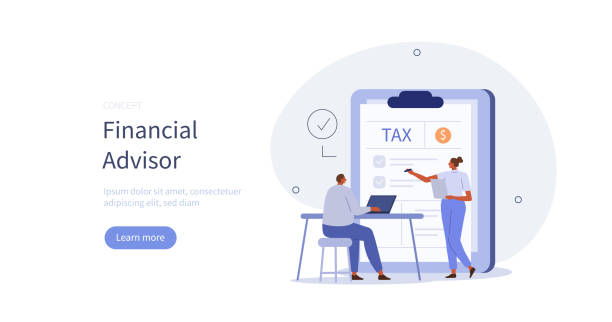Introduction to SEO-Friendly Website Design and Its Vital Importance

In today’s digital world, where the competition for visibility has reached its peak, merely having a website is not enough; your website must be visible in search engines.
This is where the concept of #SEO-friendly website design comes in.
An SEO-friendly website (SEO-friendly website design) means building a website that is optimized from the outset with search engine algorithms and user experience in mind.
This approach ensures that your website is not only easily #understandable and #indexable by search engine crawlers but also achieves a higher ranking in search results.
The importance of SEO-friendly website design lies in its ability to drive organic (free) and targeted traffic to your business.
Without SEO, even the best content or services may never reach their target audience.
In fact, SEO is a long-term #investment that yields significant returns in increasing your online visibility and credibility.
A correct understanding of SEO principles and their implementation from the design phase to website maintenance is key to success in today’s competitive online space.
This includes site structure, loading speed, content quality, and overall user experience, all of which work hand-in-hand to form a truly SEO-friendly website.
Are you dissatisfied with your e-commerce site’s low sales?
Rasaweb is your solution for a professional and high-selling e-commerce site.
✅ Significant increase in sales and revenue
✅ Easy and enjoyable shopping experience for customers
⚡ Get a free consultation from Rasaweb right now!
Main Pillars of SEO in Website Design from Technical and Content Perspectives

SEO-friendly website design encompasses two main dimensions, technical and content-related, both equally vital for website success.
From a technical standpoint, optimization includes aspects such as code structure (clean and standard HTML/CSS/JavaScript), site loading speed, responsiveness (compatibility with various devices), security (using HTTPS), and the ability for #crawling and #indexing by search engines.
A site with a weak technical structure, even if it has excellent content, will hardly be seen in search results.
For example, using an XML sitemap and a robots.txt file to guide search engine crawlers is essential.
On the other hand, the content dimension focuses on producing valuable, unique, and relevant content for target keywords.
This includes optimizing titles, meta descriptions, proper use of Heading tags (H1-H6), and ensuring text readability and engagement for users.
An SEO-friendly website design must strike a balance between these two aspects.
High-quality content without strong technical support, or a flawless technical infrastructure without engaging content, are both insufficient on their own.
Ultimately, the goal of SEO is to provide the best possible user experience, as search engines pursue the same goal and prioritize websites that satisfy users.
Content Optimization for Seamless SEO and User Experience

One of the main pillars of SEO-friendly website design is content optimization, which is closely linked to user experience (UX).
High-quality content not only attracts users but also convinces search engines that your website is a reliable source.
To begin, keyword research is the first step.
You need to identify the words your target audience uses to search for your services or products.
However, merely keyword density is not enough; the content must be comprehensive, responsive to user needs, and add value.
Proper use of heading tags (H1, H2, H3) for text organization, short paragraphs, relevant images and videos, and clear calls to action (CTA) all help improve readability and user engagement.
Furthermore, optimizing titles and meta descriptions for each page is crucial, as these are the first things users see in search results.
An SEO-friendly website design focuses on content that is not only optimized for search engines but also engaging and useful for users, as the ultimate goal is to attract and retain the audience.
Content quality is directly related to user dwell time on the site, bounce rate, and ultimately the site’s search ranking.
| Element | Importance for SEO | Importance for UX | Solution |
|---|---|---|---|
| Keyword Research | High | Medium | Using keyword research tools and analyzing user intent |
| Content Quality and Depth | High | High | Producing comprehensive, unique, and user-needs-responsive content |
| Optimizing Titles and Meta Descriptions | High | High | Engaging and relevant to main keywords |
| Heading Structure (H1-H6) | Medium | High | Logical use for content organization |
| Optimized Images and Videos | Medium | High | Compression, Alt tag, relevance |
| Internal Linking | High | Medium | Connecting related pages to improve navigation |
Website Loading Speed and Responsiveness Affecting SEO

Website loading speed and its responsiveness are two crucial factors in SEO-friendly website design that directly impact user experience and search engine rankings.
In today’s world, users expect websites to load within a few seconds, and any delay can lead to site abandonment and an increased bounce rate.
Google and other search engines are well aware of this and penalize slow websites.
Tools like Google PageSpeed Insights can help you identify speed issues.
Image optimization, code compression (CSS, JavaScript, HTML), using browser caching, and choosing suitable hosting are among the solutions for increasing speed.
In addition to speed, site responsiveness, meaning website compatibility with different screen sizes (mobile, tablet, desktop), is also of high importance.
Given the significant increase in mobile usage for internet access, Google has adopted mobile-first indexing for years, meaning your website’s mobile version is more important for ranking.
An SEO-friendly website design must prioritize these two technical aspects to pass muster with search engines and users.
Do you dream of a thriving online store but don’t know where to start?
Rasaweb is your comprehensive e-commerce website design solution.
✅ Attractive and user-friendly design
✅ Increased sales and revenue⚡ Get a free consultation
URL Structure and Site Information Architecture for Optimal Navigation

The URL structure and information architecture of a website play a key role in SEO-friendly website design.
Readable and meaningful URLs, known as “SEO-friendly” URLs, not only help users understand the page’s content before clicking but also provide valuable information to search engines.
Short URLs containing relevant keywords and free of complex characters aid better crawling and indexing.
For example, instead of a URL like `yoursite.com/cat/id=123&page=456`, using `yoursite.com/products/laptops/gaming` is much more SEO-friendly.
Alongside URLs, site information architecture, or the website structure, is also of great importance.
A logical hierarchical structure that places main pages close to the home page and uses appropriate internal linking to connect related pages helps search engines understand the topicality and importance of different pages.
Furthermore, this structure allows users to easily navigate the site and access the content they are looking for.
Using breadcrumbs is also recommended for improving user experience and SEO.
These elements all indicate to search engines that a site is well-organized and, consequently, earns a higher ranking score.
The Role of Backlinks and Domain Authority in Site SEO

Within the framework of SEO-friendly website design, backlinks and domain authority are among the most important off-page SEO factors that signal your website’s credibility and authority to search engines.
A backlink means links given to your site from other websites.
Search engines view backlinks as a vote of confidence in your content; the greater the number and quality of backlinks, the higher your site’s credibility and authority in the search engine’s eyes.
However, quality precedes quantity.
A backlink from a reputable and relevant website is worth far more than dozens of backlinks from low-authority and irrelevant sites.
Building quality backlinks requires various strategies, including producing valuable and shareable content, establishing relationships with bloggers and influencers, and participating in relevant online communities.
Domain Authority (DA) is also a metric provided by tools like Moz that predicts how likely your domain is to rank well in search results.
Although DA is not an official Google metric, it provides a general insight into your site’s position compared to competitors.
An SEO-friendly website design cannot solely focus on on-page optimization; it must also have a comprehensive plan for building quality backlinks and increasing domain authority to reach its full potential.
SEO Monitoring Tools and Techniques for Performance Evaluation

After implementing the principles of SEO-friendly website design, monitoring and tracking site performance is of paramount importance.
Without the right tools, identifying strengths and weaknesses and performing subsequent optimizations would be impossible.
Tools like Google Search Console and Google Analytics, two vital free tools from Google, provide valuable information about how the site is indexed, the keywords users use to find your site, page performance, and user behavior on the site.
Search Console allows you to identify crawling issues, 404 errors, and security problems, while Analytics offers deep insights into traffic sources, bounce rate, dwell time, and user paths on the site.
In addition, paid tools like Ahrefs, SEMrush, and Moz offer more advanced features such as competitor backlink analysis, keyword rank tracking, and technical SEO monitoring.
SEO-friendly website design is not a static process, but a continuous effort that requires data analysis and adaptation to changes.
By using these tools, site performance can be accurately monitored, SEO strategies improved, and potential problems prevented.
| Tool | Type (Free/Paid) | Key Features | Suitable for |
|---|---|---|---|
| Google Search Console | Free | Crawl and index reports, search performance, site issues, sitemaps | Website owners, beginner SEOs |
| Google Analytics | Free | Website traffic, user behavior, traffic sources, conversions | Marketers, web analysts, business owners |
| Ahrefs | Paid | Backlink analysis, keyword research, competitor analysis, site audit | SEO specialists, digital marketers |
| SEMrush | Paid | Keyword research, competitor analysis, content SEO, paid advertising | SEO specialists, content marketers, digital marketing agencies |
| Moz Pro | Paid | Keyword research, link analysis, SEO audit, rank tracking | SEO specialists, small and medium-sized businesses |
Coping with Google Algorithm Changes and Maintaining Ranking

The world of SEO is constantly changing, and SEO-friendly website design is not a one-time task.
Google’s algorithms are continually updated, and these changes can significantly impact website rankings.
Some of these updates are minor, while others, like Core Updates or updates related to helpful content, are extensive and influential.
The important question is: how can one cope with these changes and maintain site ranking? The answer is summarized in one word: quality.
Google always aims to provide the best and most relevant results to users.
Therefore, every algorithm change is usually made to improve user experience and identify higher-quality websites.
To maintain ranking in an SEO-friendly website design, one must focus on producing valuable and comprehensive content, continuously improving user experience, and adhering to technical SEO principles.
Tracking SEO industry news, studying expert analyses, and experimenting with new approaches can help you stay ahead of changes.
Flexibility and adaptability to the evolving SEO environment are hallmarks of a successful SEO-friendly website design strategy.
Are you missing business opportunities because of an outdated website? With Rasaweb, solve the problem of not attracting potential customers through your website forever!
✅ Attract more high-quality leads
✅ Increase brand credibility in the eyes of customers
⚡ Get a free consultation for corporate website design
Common Mistakes in SEO-Friendly Website Design and How to Avoid Them

When designing an SEO-friendly website, avoiding common mistakes is just as important as correctly implementing principles.
One of the most common mistakes is the excessive use of keywords (Keyword Stuffing), which is not only annoying for users but also identified and penalized by search engines as a spam tactic.
Content should be natural and fluid.
Another mistake is low-quality or duplicate content (Thin Content/Duplicate Content).
Pages with little content or copied from other sites have little value for users and search engines and harm the site’s ranking.
Also, broken links and technical issues like slow loading speed or lack of responsiveness can ruin the user experience and send negative signals to search engines.
Ignoring technical SEO at the beginning of design, not optimizing images, or a complex navigation structure are also common mistakes in SEO-friendly website design.
To avoid these, a comprehensive SEO strategy must be integrated into the design and development process from the outset, the site must be continuously audited, and problems identified and fixed using monitoring tools.
Furthermore, focusing on user satisfaction and providing real value is the best way to ensure sustainable and successful SEO.
The Future of SEO-Friendly Website Design and Final Summary

The future of SEO-friendly website design is closely linked to technological advancements and changes in how users interact with the internet.
Voice Search is rapidly growing, which means a shift in keyword research from short phrases to full, conversational questions.
Also, Artificial Intelligence (AI) plays an increasing role in search engines’ understanding of user intent and content.
This means websites must focus more than ever on providing comprehensive and relevant answers rather than merely optimizing for specific keywords.
Core Web Vitals and page experience metrics also indicate that Google places increasing importance on actual performance and users’ visual experience.
Therefore, an SEO-friendly website design in the future must continuously focus on technical aspects, speed, security, and delivering quality and responsive content.
Ultimately, SEO is an endless journey of learning and optimization.
A website that constantly updates its content, remains technically optimized, and prioritizes user experience can expect to remain successful in today’s and tomorrow’s competitive online world.
SEO-friendly website design is not just a tactic, but a philosophy for a successful and sustainable presence in the digital space.
Frequently Asked Questions
| Question | Answer |
|---|---|
| What does SEO-friendly website design mean? | Designing a website that, in addition to an attractive appearance, is technically and content-wise optimized to achieve a higher ranking in search engine results. |
| Why is SEO-friendly website design important? | It increases organic traffic through search engines, improves business visibility, attracts more customers, and ultimately boosts sales. |
| What are the key elements in SEO-friendly website design? | Mobile optimization, fast loading speed, high-quality and relevant content, proper use of keywords, appropriate URL structure, and usage of title and meta tags. |
| What role does content play in site SEO? | Unique, valuable, informative content with target keywords plays a vital role in attracting users and achieving better rankings in search results. |
| What is Mobile-First Indexing? | A Google approach where the mobile version of a website is prioritized for indexing and ranking. Therefore, site responsiveness for mobile is essential. |
| How can site loading speed be improved? | Compressing images, using caching, optimizing CSS and JavaScript codes, using strong hosting, and enabling Gzip compression. |
| What is the importance of keywords in SEO? | Keywords help search engines understand the topic of your page and link it to relevant user searches. |
| What role do Title Tags and Meta Descriptions play? | The title tag is the most important element in on-page SEO, and the meta description is a summary of the page’s content that encourages users to click. Both are displayed in search results. |
| How does Internal Linking help with SEO? | It helps search engines discover and index different pages of the site and distributes page value across different sections of the site. It also improves user experience. |
| What is the use of a Sitemap in SEO? | It is an XML file that provides a list of all important pages on the site to search engines to facilitate site crawling and indexing. |
And other advertising services by Rasa Web Advertising Agency:
Smart Website Development: A professional solution for customer acquisition focusing on real data utilization.
Smart Marketplace: A blend of creativity and technology for user interaction through key page optimization.
Smart Social Media: A professional solution for customer acquisition focusing on precise audience targeting.
Smart UI/UX: Designed for businesses aiming to increase click-through rates through user experience customization.
Smart UI/UX: A fast and efficient solution for user interaction focusing on attractive user interface design.
And over hundreds of other services in internet advertising, advertising consultation, and organizational solutions.
Internet Advertising | Advertising Strategy | Advertorials
Resources
SEO Principles and Website Optimization
Video Tutorial on SEO-Friendly Website Design
What is SEO-Friendly Website Design?
At Rasaweb Afarin Digital Marketing Agency, we turn your digital dreams into reality. With our diverse and specialized services, including professional website design, have a powerful and distinct presence in the online world and elevate your business.
📍 Tehran, Mirdamad Street, next to Bank Markazi, Southern Kazeroon Alley, Ramin Alley, No. 6
✉️ info@idiads.com
📱 09124438174
📱 09390858526
📞 02126406207

